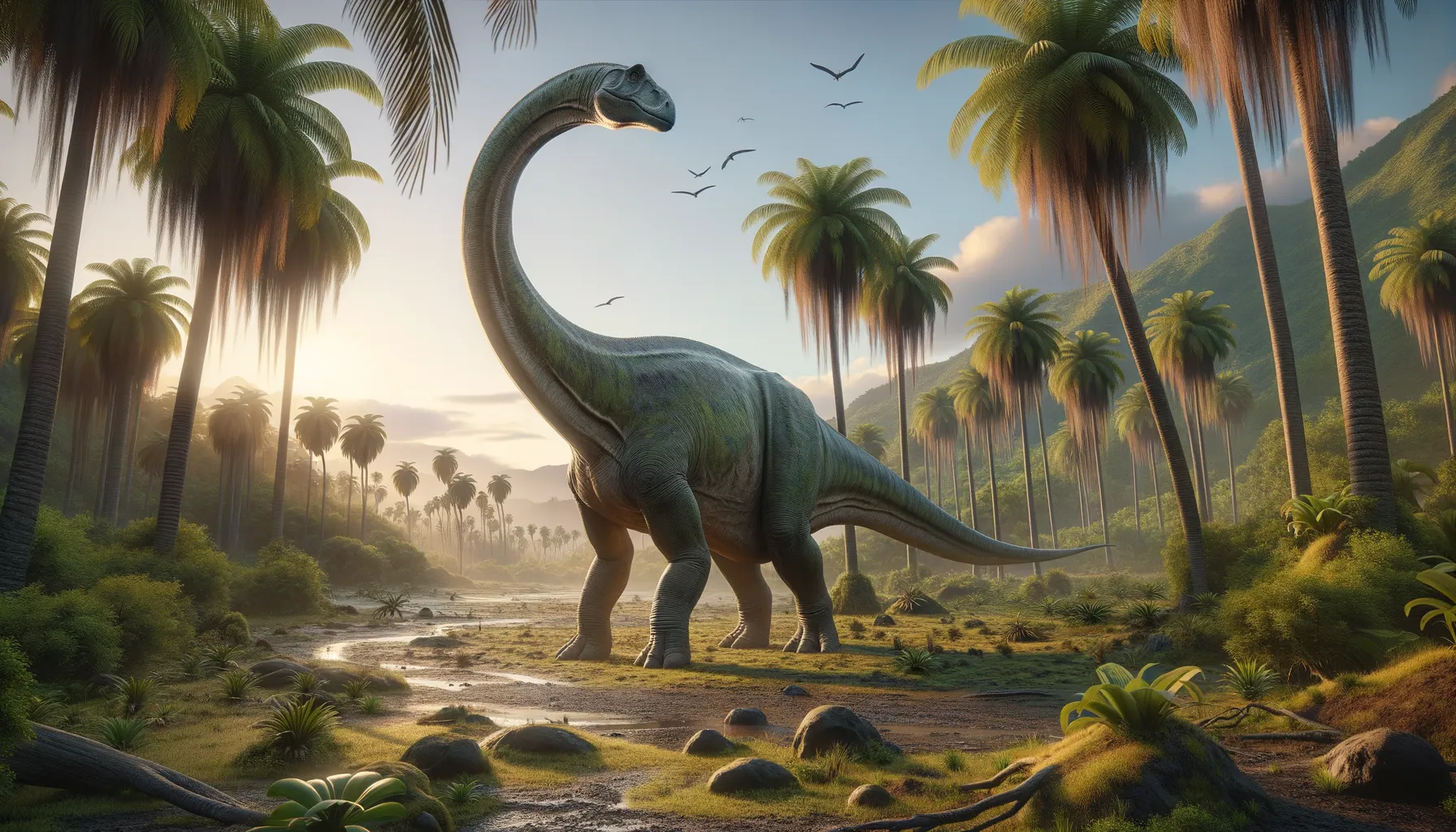
Volkheimeria
Gentle giant of the ancient forests.
Period
Jurassic
Length
Likely reached lengths of about 15 meters.
Height
Approximately 4 meters tall at the hips.
Weight
Estimated to weigh around 10 metric tons.
Volkheimeria was a massive, long-necked dinosaur from the Early Jurassic period. Known for its size and plant-eating habits, it roamed what is now South America. This sauropod had robust limbs to support its heavy body. Despite its intimidating size, Volkheimeria was a gentle giant, thriving on the lush vegetation around it. Its discovery has provided valuable insights into the evolution of sauropod dinosaurs and their early diversification.
Diet
Volkheimeria was herbivorous, feeding mainly on low-lying plants and ferns. Its long neck allowed it to reach various plant heights, giving it access to diverse vegetation.
Hunting
As a herbivore, Volkheimeria did not hunt for prey. It foraged for plants in dense forests and open plains, using its large size to reach food sources inaccessible to smaller species.
Environmental challenges
Volkheimeria faced challenges such as changes in vegetation due to climate fluctuations typical of the Jurassic period. Moreover, competition with other herbivorous dinosaurs likely exerted pressure on available resources. Predators may have also posed a threat, necessitating its large size as a defense mechanism. Adaptation to differing terrains would have been essential for survival.
Speed
Comparable to a slow modern-day elephant.
Lifespan
Likely lived for several decades.
First discovery
First discovered in Patagonia, Argentina.
Fun Facts
- Volkheimeria was a dinosaur from the early Jurassic period, making it one of the earlier sauropods to roam the Earth.
- This dinosaur was named after Argentine geologist Wolfgang Volkheimer, who contributed to the understanding of the fossil-rich regions in South America.
- Volkheimeria was a herbivore, which means it fed on plants using its long neck to reach high vegetation.
- It lived in what is now known as Argentina, showcasing that many dinosaur species thrived in the Southern Hemisphere.
- Volkheimeria was a small sauropod compared to later relatives, giving us insights into the evolution of giant long-necked dinosaurs.
- Fossils of Volkheimeria help paleontologists understand the diversity and spread of early sauropods in prehistoric ecosystems.
Growth and Development
Volkheimeria likely hatched from eggs and experienced rapid growth to reach its massive size. This growth phase would have required substantial nutrition and protection during vulnerable stages. As it matured, it developed its characteristic long neck and robust body, optimizing it for a plant-based diet. Its bone structure suggests a well-adapted physiology for supporting extreme weight.
Habitat
Volkheimeria inhabited regions rich in vegetation, such as coniferous forests and fern plains of the early Jurassic South America. The environment provided ample food sources and water to sustain its large population. Seasonal variations might have affected its movement patterns, prompting migrations to resource-rich areas. The region's vast open spaces were ideal for its size.
Interaction with other species
This dinosaur coexisted with various other species, including both predators and fellow herbivores. Its peaceful nature likely led to minimal conflict with other herbivores. Defensive behaviors may have included traveling in groups to deter predators. Interaction with predators was likely rare due to its size, but young or weak individuals might have been targeted.
Natural lifespan
Volkheimeria likely had a natural lifespan of several decades.
Reproduction
Volkheimeria reproduced by laying eggs, which were likely incubated under natural conditions like sunlight or covered in vegetation. It might have built nests to protect its eggs from predators and environmental elements. The reproductive cycle could have been influenced by environmental cues such as temperature and food availability. Hatchlings would have required a lengthy developmental period before reaching full maturity.
Social behaviour
Volkheimeria is thought to have traveled in herds, providing safety in numbers. Social structures may have been loose, with individuals coming together primarily for feeding and mating purposes. Communication within the group could have included vocalizations or visual signals to coordinate movements or respond to threats. Its social behavior would have been crucial for the survival of young and vulnerable members.
Fossil locations
Fossils of Volkheimeria have been primarily found in Patagonia, Argentina, specifically in the Los Molles Formation. These fossils have played a crucial role in understanding the early development of sauropod dinosaurs. The region's geological conditions have helped preserve these remains, offering vital insights into the creature's anatomy and lifestyle. Discoveries here have expanded knowledge of the distribution and diversity of early sauropods.
